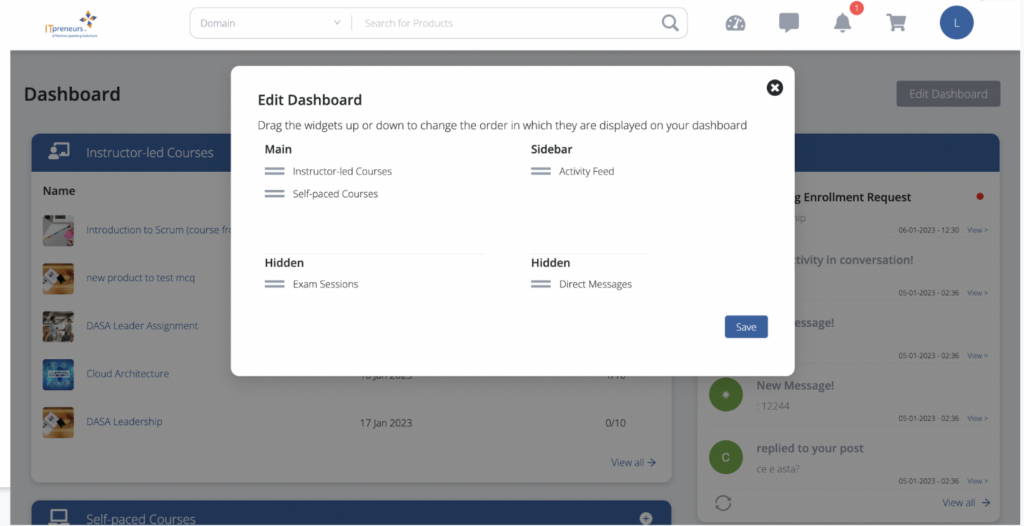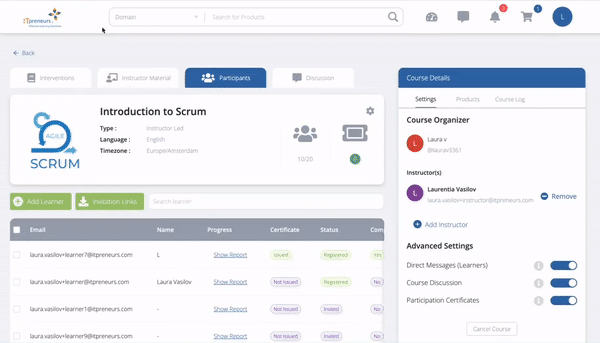We are bombarded with online and virtual training on any topic you could imagine. Individuals, organizations, and education services offer some shape or form of training with big promises. Most of these concentrate on what you will learn and less on how they will accomplish the result. Are we getting our time worth of learning? You spend your time; it might be a couple of hours or days to understand what they are teaching. Do you really learn what has been promised?
The context of the training is important here, too. If you are learning hard factual technical content, such as tools and techniques, yes, you might gain knowledge as long as the content is proven correct. How about teaching soft skills?
As noted on the Embracing Digital Disruption by Adopting DevOps Practices whitepaper published by DASA, “organizations that have been dramatically transforming by adopting an engineering culture, and moving towards a new world of IT.” The new world is quite different from the previous ones. An individual’s skills and competencies are playing a bigger role. Digital transformation requires deep cultural and organizational change. That means changing behavior — a lot. It means throwing out decades of embedded explicit and implicit practices.
We all have to adapt to a new reality. Most of the learning and training will be facilitated by online instructors. This will not only be the case during pandemic times but become an established way of learning and facilitating for many people.
This paper will discuss and recommend a number of learning methods in a mainly online setting.
Table of Contents
Approach
We all have to rethink and develop new ways to teach our students, whether in person or virtual. There are many teaching and lecturing models, such as Feedback-Based, Experiential, Activity-Based, and Flipped-Classroom. How can we achieve the highest impact and ensure the learner retains the knowledge taught during the class?
If you are into DevOps, you may have heard the “Three-Ways” principles; Systems Thinking, Feedback Loops, and Continual Experimentation. Three Ways, which are the principles that all of the DevOps patterns can be derived. These were used by Gene Kim to describe the values and philosophies that frame the processes, procedures, practices of DevOps, as well as the prescriptive steps. We follow the Three-Ways principles to structure our teaching model:
The First Way: Systems Thinking
Using The First Way is about creating flow between the instructor and the participants. We all want the teaching/learning flow to be as smooth and continuous as possible. In a physical world, it means good facilities, ventilation, and plenty of light and fresh air as well as a working projector showing the material presented in decent quality. People have to be close enough to hear the trainer and close enough to each other for typical classes without a microphone’s aid.
The online experience takes on a whole new set of obstacles and requirements to be working. People will have to be on a decent internet connection with a working camera and audio. As well as being in an uninterrupted environment, the flow can be kept by laying out ground rules about sharing video feed for all participants and using collaboration tools (whiteboards), and break out rooms to create a group-feeling online.
The Second Way: Amplify Feedback Loops
In order to create feedback loops, we have to engage with each other. In the physical world, it is a time-tested skill of most human beings to decipher and acknowledge visual clues from each other all the time.
To keep the engagement and the flow (the first way) is not an easy task online. Whenever possible, it is good to activate physical movements, raising your hand (physically) and nodding with your head. Encourage to keep the microphone on most of the time, depending on the number of participants.
Whenever it is possible to react to input, questions, or just emotional cues, it should be embraced and taken into the material’s delivery.
The Third Way: Culture of Continual Experimentation and Learning
The third way of continual experimentation is the most important, in our opinion. As the tools develop, you should be able to consider them in your teaching.
Physical delivery of teaching and learning is a more static (well-established) way. The online teaching options move faster with new collaboration tools and new feature development in existing tools. In order to learn both as an instructor and as a participant, you should create an agile mindset of experimentation. Doing a retrospective after each exercise and establishing improvements for further use.
As a result, we applied the following teaching models to the three-ways principles and documented our findings here.
Teaching Models
There are so many different teaching approaches and frameworks; however, for this paper, we selected only the following models:
- Experiential Teaching
- Evidence-based Teaching
- Flipped learning
We made this choice because we found the above methods flexible and easy to tailor when building your teaching model.
Experiential Teaching
Let me ask ‘how do we best learn’? From experience. Therefore, experiential teaching, as the name indicates, aims to create an environment or setting where the students can learn by experience. The challenge is creating a real-world setting or environment when we are in a classroom or virtual room, using video conferencing software like Zoom or Skype. The answer is to create exercises and/or tell stories to visualize and have the students be aware and focus on what they “feel” as they go through the exercise.
During the exercise or while visualizing the story, the instructor leads the students and helps them recognize, document, and understand what they are feeling, what comes to mind for that particular situation. In addition to recognizing and understanding the “why.” The key to being successful is for the instructor to create their curriculum to be exercise-based, facilitating a series of exercises built upon the previous exercise. The exercises are recommended to be 10 minutes in duration to reflect at the end of the exercise. The reflection time’s primary goal is for the instructor to ensure participants experienced what was expected from the exercise so that they have the building block for the exercises that will follow. Another important reason for reflection is to build up the habit of conducting retrospectives on a regular cadence.
At the completion of the course, the participant’s experience should represent real-world experiences. The instructor’s goal is to provide the students with a memorable or impactful experience. When the student is in a similar real-world situation, they will instinctively react in real-time based on their classroom experience.
Evidence-based Teaching
If you teach social skills, such as leadership, coaching, negotiations, conflict resolution, the lecturing style will not be successful. No one becomes a coach, a leader, or a negotiator after reading a book, attending a 3-day lecture, and passing the multiple-choice exam. Cognitive development occurs as the result ofshared experiences, discussions, and participation in activities with others in an environment.
The evidence-based teaching model is used to ensure the learners’ social cognitive development as much as their knowledge is enriched. Social cognition development involves interactions with others in a shared environment, such as an in-person or virtual classroom.
As an instructor, it is crucial that you clarify the course’s objective and each session’s objectives. You should gather the related evidence to be presented and discussed in each class. Keep in mind that the evidence must be supported by hard facts, not what you believe, untested theories, or anecdotal cases. It should have a substantially higher impact on participants’ learning and be related to the content you are delivering.
Teaching involves sharing information or knowledge with your students while modeling how it is applied. Once you deliver the content and provide the related evidence, then you should check for their understanding before moving onto the next part of their lesson. Techniques such as randomized sampling and explain-a-classmate help you to check their understanding. In the end, ask your students to summarize the content visually with help ofmind maps, flow-charts, and Venn diagrams. A summary should include what they have learned and to understand the interrelationships between the multiple aspects of what you have taught them.
Flipped learning
To define flipped learning, you have to consider a normal learning situation. The instructor lectures the participants, whether online or in-person. The time spent in class is normally used with the trainer educating from slides or other material. The participants will engage in discussions at various points in time, depending on how good the trainer is at engaging
Flipped learning takes another approach, and time spent in class is all about group exercises and applying concepts. On the other hand, the participants will need to engage with the material before or after the class, through individual learning. This can be done, for example, by reading or watching online material from the instructor or other valuable sources.
Some would argue that creating a flipped classroom is enough to change the traditional order by having students read texts or watch videos outside class and use the time during the class to apply the material learned. Flipped learning only occurs when the trainer truly creates a group learning environment.
The concept of flipping the classroom and the learning style shifts the classroom from passive to active learning. By applying and exploring the content, the participants will find meaning and transform mere information into actual knowledge.
We believe that learning should not be an experience like watching a sports game; it should be like participating in the game. From this way of thinking, it is incumbent upon the instructors and curriculum developers to create their classroom experience to be as close to reality as possible.
How to Develop your Unique Teaching Model?
Prepare a Teaching Structure
As we know now, learners acquire knowledge from their interactions in real-life situations in their social-environment; they are part of it. Having a class with participants who had diverse experiences, from different organizations, different backgrounds, and roles, and organize with various activity settings, such as discussions, practices, and assignments that encourage interactions.
Understanding we all come from different life experiences, the classroom is an opportunity to show students how to learn from one another. It is incumbent upon the instructor to set or create a baseline, defining the meaning of various ways of thinking and feeling for their class. For example, if I say we are going to “walk through how to tie your shoe,” ten students may have up to ten different ways to think about the sequence and what they feel about tying their shoe. The instructor leads by example, demonstrates tying their shoe, and for each step, shares what is going on inside of them, what they are thinking or feeling. As the instructor is going through the exercise, the students reflect on what is going on inside themselves, comparing how they go through the motions of tying the shoe. The end result is the student now has a method of comparison and association. As the student goes through the class, he can now relate his own life experiences to the instructor and their teammates. When in discussions with their teammates, they have a common reference point or example which they can use to help understand one another.
The learner and the physical environment must be viewed as an active state, rather than a static state. The same content is delivered the same way repeatedly for all classes.
Create a Flexible Teaching Environment
Extensive information is available in the coursebook; however, the delivery of the content, examples, case studies, activities, and assignments is adjusted based on the participants’ experience and skill levels.
The curriculum developer and instructor should construct the exercises, so they are a progression. Start out with the basic core information used as the foundation of the subject matter. As the exercises build upon one another, increase the complexity of the exercise. When we “increase the complexity,” we mean not just the exercise steps but also to challenge the students in more sophisticated associations of their life experiences. For example, in the first exercise, the goal is to have the student associate a feeling of “good” versus “bad.” In a future exercise, the goal is to have the student associate a feeling of “honorable” versus “non-honorable.”
Design Intentional Content
Conceptual content is developed by determining what needs to be taught. Some topics are critical for learners. Those topics have self-studying content and then activities and assignments to enhance learning. Other topics are available to learners simply as a reference.e. This approach allows educators to minimize classroom time for content delivery and increase classroom time for practicing concepts key to learners.
For experience-based training, the intent is to create a series of exercises that build upon one another with the end state. It provides the student with the most realistic experience possible for their real-world situation. The content needs to be focused on being prepared for various situations: the content needs to include when things go according to the plan and when things go wrong or not according to the plan. Each industry or role has common risks that are part of doing business. To best train the students, the mitigation for these common risks needs to be included in the training.
Engage with Expert Educators for Advice and Feedback
What is needed for an educator to be considered an “expert educator”? The main requirement is that he is a subject matter expert. DASA instructors are subject matter experts with a combination of experience in the field as well as experience as an instructor.
Participating in DASA Instructor communities, listening to their experiences, participating in discussions, and practicing their recommendations, will help you alter and improve your skills. This results in a better experience for students themselves.
Choose and Implement Your Approach
As a trainer, you need to consider your options on how to implement a teaching approach.
Consider what normal homework is and what can be facilitated in class under the guidance of the trainer.
Have your homework assignments be a series of various self-led exercises to provide the student with the opportunity to gather a variety of sensations or feelings. The instructor can then review the homework exercises, their desired outcomes, and then associate these outcomes to various real-world working scenarios in class. We recommend the instructor provides scenarios for both positive and negative outcomes. This is the real world. The instructor should facilitate scenarios, explain, and have the students validate how the exercise experiences would feel or be applied depending on whether they went according to plan or not.
It is best to have the students describe their viewpoint of these scenarios. By having the students describe to their teammates, they’re incentivized to to self-reflect, sort through how they can associate their life experiences to the exercise, and then communicate this complex thinking in understandable terms. Being able to communicate in an easy-to-understand manner is really important and adds to the experience of learning. The classroom is a safe environment. It is better for the students to work out their inner association and communication skills in the classroom environment than in real-world situations.
Effective way of application
Lectures on certain topics can be recorded and watched asynchronous of the class, before or after the direct engagement with the trainees. Alternatively, certain texts, articles, videos could be shared as part of homework. Assignments on how to apply the theory should be reserved for class time.
In retrospect, learning opportunities may arise where there are different ways to interpret the same concept. Preferably, difficult or challenging content should be taught with the activities. Online-delivered classes should consider collaboration tools to increase participant engagement.
When assigning the homework, provide the instructions or guidance for conducting it and as well as on what they should feel while doing it. Create and reinforce the awareness of what is going on in the real world environment around them, as well as what is going on internally inside of themselves.
How are their emotions and feelings resulting in their reactions to what is going on around them? Are their reactions:
- Personally, desired?
- Personally manageable?
- Helping correct the situation?
- What the team needs?
- Typical of a leader or a follower?
- Helping or hindering?
Summary
As you can see, there is no one perfect model applicable to all types of content and level of participants. Before any decision, you should assess the participant’s knowledge level and their learning styles, either by a short survey before the course or during the introduction session. Once you have this information, choose a model or mix & match models to create your best teaching model for your course.
It is a mindset and a way to demonstrate for everybody that one thing is to “know” the material and another to deliver it. Both aspects should be kept in mind as a trainer. The expert educator can maximize classroom time to adopt individual-centred methods and the level of class expertise.
The following strategies will increase your success rate regardless of the teaching model:
- Feedback from the students determines how we, as the instructor, mix and match the models, i.e., Flipped classroom, Evidence-based learning, and Experiential Learning. Giving feedback involves letting your students know how they have performed on a particular task along with ways that they can improve. Feedback provides your students with a tangible understanding of what they did well, where they are at, and how they can improve.
- As the saying goes, practice makes it perfect. Practice helps students retain the knowledge and skills they have learned while also allowing you to check for understanding. If you want to harness the potent power of practice, you must ensure that your students practice the right things.
- Add group activities to enhance learning because students tend to learn better when they are with their peers. Keep in mind that you should only ask groups to do tasks that all group members can do successfully.
- Sometimes you should be more of a facilitator than a trainer when running exercises.
The final point is that learning should start from enrollment, and optimally should occur before the scheduled session goes live with the instructor. In between scheduled sessions, a lot of learning can happen, digesting and anchoring the material and collaborating in groups or self-study offline.
References:
About the author

Agile Transformation Consultant, Lean / Agile Coach, Master Trainer, Senior Program Manager with the results-oriented approach for over 20 years. Continuous achievements in managing projects using traditional and agile methodologies and work closely with the process owners and teams to get the work done. Advocate for agile principles by modeling those principles and values in order to develop a shared mindset across teams as well as between the customer and the team.

John is a Transformation Leader / Officer who has been ‘Transforming Your Ideas Into Reality’ (TYIIR) for the world’s leading individuals, organizations, and governments. His experiences include DevOps / DevSecOps, Digital Transformations, CICD, Agile, global disruptive technology development programs, mission-critical critical business initiatives, government programs, and operations.

Jakob is an experienced Digital Transformation Coach, ITIL Expert, DevOps, and Agile certified trainer. He is heavily invested in advising large and medium-sized companies on their digital journey and transformation. Jakob has specialized primarily in IT Service Management and Project Management subjects.



